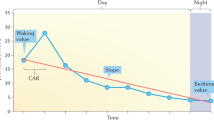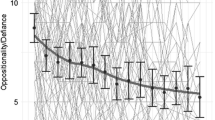Abstract
Variations in adrenal and gonadal hormone profiles have been linked to increased rates of oppositional defiant disorder (ODD) and conduct disorder (CD). These relationships suggest that certain hormone profiles may be related to how well children respond to psychological treatments for ODD and CD. The current study assessed whether pre-treatment profiles of adrenal and gonadal hormones predicted response to psychological treatment of ODD and CD. One hundred five children, 6–11 years old, participating in a randomized, clinical trial provided samples for cortisol, testosterone, dehydroepiandrosterone, and androstenedione. Diagnostic interviews of ODD and CD were administered up to 3 years post-treatment to track treatment response. Group-based trajectory modeling identified two trajectories of treatment response: (1) a High-response trajectory where children demonstrated lower rates of an ODD or CD diagnosis throughout follow-up, and (2) a Low-response trajectory where children demonstrated higher rates of an ODD or CD diagnosis throughout follow-up. Hierarchical logistic regression predicting treatment response demonstrated that children with higher pre-treatment concentrations of testosterone were four times more likely to be in the Low-response trajectory. No other significant relationship existed between pre-treatment hormone profiles and treatment response. These results suggest that higher concentrations of testosterone are related to how well children diagnosed with ODD or CD respond to psychological treatment over the course of 3 years.

Similar content being viewed by others
References
APA. (2000). Diagnostic and statistical manual of mental disorders (4th ed., text revision). Washington, DC: American Psychiatric Association.
Brotman, L. M., Gouley, K. K., Huang, K.-Y., Kamboukos, D., Fratto, C., & Pine, D. S. (2007). Effects of a psychosocial family-based preventive intervention on cortisol response to a social challenge in preschoolers at high risk for antisocial behavior. Archives of General Psychiatry, 64(10), 1172–1179.
Constantino, J. N., Grosz, D., Saenger, P., Chandler, D. W., Nandi, R., & Earls, F. J. (1993). Testosterone and aggression in children. Journal of the American Academy of Child and Adolescent Psychiatry, 32(6), 1217–1222.
Dmitrieva, T., Oades, R., Hauffa, B., & Eggers, C. (2001). Dehydroepiandrosterone sulphate and corticotropin levels are high in young male patients with conduct disorder: Comparisons for growth factors, thyroid and gonadal hormones. Neuropsychobiology, 43(3), 134–140.
Dorn, L. D., Kolko, D. J., Susman, E. J., Huang, B., Stein, H., Music, E., et al. (2009). Salivary gonadal and adrenal hormone differences in boys and girls with and without disruptive behavior disorders: Contextual variants. Biological Psychology, 81(1), 31–39.
Eyberg, S. M., Funderburk, B. W., Hembree-Kigin, T. L., McNeil, C. B., Querido, J. G., & Hood, K. K. (2001). Parent-child interaction therapy with behavior problem children: One and two year maintenance of treatment effects in the family. Child & Family Behavior Therapy, 23(4), 1–20.
Fisher, P. A., Stoolmiller, M., Gunnar, M. R., & Burraston, B. O. (2007). Effects of a therapeutic intervention for foster preschoolers on diurnal cortisol activity. Psychoneuroendocrinology, 32(8–10), 892–905.
Foote, R. C., Schuhmann, E. M., Jones, M. L., & Eyberg, S. M. (1998). Parent-child interaction therapy: A guide for clinicians. Clinical Child Psychology and Psychiatry, 3(3), 361–373.
Granger, D. A., Schwartz, E. B., Booth, A., & Arentz, M. (1999). Salivary testosterone determination in studies of child health and development. Hormones and Behavior, 35(1), 18–27.
Hemphill, S. A., & Littlefield, L. (2001). Evaluation of a short-term group therapy program for children with behavior problems and their parents. Behaviour Research and Therapy, 39(7), 823–841.
Henggeler, S. W., Schoenwald, S. K., Borduin, C. M., Rowland, M. D., & Cunningham, P. B. (1998). Multisystemic treatment of antisocial behavior in children and adolescents. New York, NY: Guilford Press.
Hill, J., & Maughan, B. (2001). Conduct disorders in childhood and adolescence. New York, NY: Cambridge University Press.
Jones, B. L., Nagin, D. S., & Roeder, K. (2001). A SAS procedure based on mixture models for estimating developmental trajectories. Sociological Methods and Research, 29(3), 374–393.
Kaminski, J. W., Valle, L. A., Filene, J. H., & Boyle, C. L. (2008). A meta-analytic review of components associated with parent training program effectiveness. Journal of Abnormal Child Psychology, 36(4), 567–589.
Kaufman, J., Birmaher, B., Brent, D., Rao, U., Flynn, C., Moreci, P., et al. (1997). Schedule for affective disorders and schizophrenia for school-age children-present and lifetime version (K-SADS-PL): Initial reliability and validity data. Journal of the American Academy of Child and Adolescent Psychiatry, 36(7), 980–988.
Kazdin, A. E. (1995). Conduct disorders in childhood and adolescence (2nd ed.). London: Sage.
Kazdin, A. E., Siegel, T. C., & Bass, D. (1992). Cognitive problem-solving skills training and parent management training in the treatment of antisocial behavior in children. Journal of Consulting and Clinical Psychology, 60(5), 733–747.
Kertes, D. A., & Gunnar, M. R. (2004). Evening activities as a potential confound in research on the adrenocortical system in children. Child Development, 75(1), 193–204.
Kolko, D., Dorn, L., Bukstein, O., & Burke, J. (2008). Clinically referred ODD children with or without CD and healthy controls: Comparisons across contextual domains. Journal of Child and Family Studies, 17(5), 714–734.
Kolko, D., Dorn, L., Bukstein, O., Pardini, D., Holden, E., & Hart, J. (2009). Community vs. clinic-based modular treatment of children with early-onset ODD or CD: A clinical trial with 3-year follow-up. Journal of Abnormal Child Psychology, 37(5), 591–609.
Lahey, B. B., Schwab-Stone, M., Goodman, S. H., Waldman, I. D., Canino, G., Rathouz, P. J., et al. (2000). Age and gender differences in oppositional behavior and conduct problems: A cross-sectional household study of middle childhood and adolescence. Journal of Abnormal Psychology, 109(3), 488–503.
Long, P., Forehand, R., Wierson, M., & Morgan, A. (1994). Does parent training with young noncompliant children have long-term effects? Behaviour Research and Therapy, 32(1), 101–107.
Maughan, B., Rowe, R., Messer, J., Goodman, R., & Meltzer, H. (2004). Conduct disorder and oppositional defiant disorder in a national sample: Developmental epidemiology. Journal of Child Psychology and Psychiatry and Allied Disciplines, 45(3), 609–621.
McBurnett, K., Lahey, B. B., Rathouz, P. J., & Loeber, R. (2000). Low salivary cortisol and persistent aggression in boys referred for disruptive behavior. Archives of General Psychiatry, 57(1), 38–43.
McCart, M., Priester, P., Davies, W., & Azen, R. (2006). Differential effectiveness of behavioral parent-training and cognitive-behavioral therapy for antisocial youth: A meta-analysis. Journal of Abnormal Child Psychology, 34(4), 527–543.
Olweus, D., Mattsson, A., Schalling, D., & Low, H. (1988). Circulating testosterone levels and aggression in adolescent males: A causal analysis. Psychosomatic Medicine, 50(3), 261–272.
Pajer, K., Gardner, W., Rubin, R. T., Perel, J., & Neal, S. (2001). Decreased cortisol levels in adolescent girls with conduct disorder. Archives of General Psychiatry, 58(3), 297–302.
Pajer, K., Tabbah, R., Gardner, W., Rubin, R., Czambel, R. K., & Wang, Y. (2006). Adrenal androgen and gonadal hormone levels in adolescent girls with conduct disorder. Psychoneuroendocrinology, 31(10), 1245–1256.
Reid, M. J., Webster-Stratton, C., & Hammond, M. (2003). Follow-up of children who received the incredible years intervention for oppositional-defiant disorder: Maintenance and prediction of 2-year outcome. Behavior Therapy, 34(4), 471–491.
Roberts, R. E., Roberts, C. R., & Xing, Y. (2007). Rates of DSM-IV psychiatric disorders among adolescents in a large metropolitan area. Journal of Psychiatric Research, 41(11), 959–967.
Scerbo, A. S., & Kolko, D. J. (1994). Salivary testosterone and cortisol in disruptive children: Relationship to aggressive, hyperactive, and internalizing behaviors. Journal of the American Academy of Child and Adolescent Psychiatry, 33(8), 1174–1184.
Serketich, W. J., & Dumas, J. E. (1996). The effectiveness of behavioral parent training to modify antisocial behavior in children: A meta-analysis. Behavior Therapy, 27(2), 171–186.
Sexton, T. L., & Alexander, J. F. (2005). Functional family therapy for externalizing disorders in adolescents. In J. L. Lebow (Ed.), Handbook of clinical family therapy. Hoboken, NJ: John Wiley & Sons Inc.
Shirtcliff, E. A., Granger, D. A., Booth, A., & Johnson, D. (2005). Low salivary cortisol levels and externalizing behavior problems in youth. Development and Psychopathology, 17(1), 167–184.
Shoal, G. D., Giancola, P. R., & Kirillova, G. P. (2003). Salivary cortisol, personality, and aggressive behavior in adolescent boys: A 5-year longitudinal study. Journal of the American Academy of Child and Adolescent Psychiatry, 42(9), 1101–1107.
Simonoff, E., Pickles, A., Meyer, J. M., Silberg, J. L., Maes, H. H., Loeber, R., et al. (1997). The Virginia Twin Study of Adolescent Behavioral Development: Influence of age, sex, and impairment on rates of disorder. Archives of General Psychiatry, 54(9), 801–808.
Susman, E. J., Dockray, S., Schiefelbein, V. L., Herwehe, S., Heaton, J. A., & Dorn, L. D. (2007). Morningness/eveningness, morning-to-afternoon cortisol ratio, and antisocial behavior problems during puberty. Developmental Psychology, 43(4), 811–822.
van Bokhoven, I., Van Goozen, S. H., van Engeland, H., Schaal, B., Arseneault, L., Seguin, J. R., et al. (2005). Salivary cortisol and aggression in a population-based longitudinal study of adolescent males. Journal of Neural Transmission, 112(8), 1083–1096.
van De Wiel, N. M. H., van Goozen, S. H. M., Matthys, W., Snoek, H., & van Engeland, H. (2004). Cortisol and treatment effect in children with disruptive behavior disorders: A preliminary study. Journal of the American Academy of Child and Adolescent Psychiatry, 43(8), 1011–1018.
van Goozen, S. H. M., Fairchild, G., Snoek, H., & Harold, G. T. (2007). The evidence for a neurobiological model of childhood antisocial behavior. Psychological Bulletin, 133(1), 149–182.
Webster-Stratton, C. (2005). The incredible years: A training series for the prevention and treatment of conduct problems in young children. In E. D. Hibbs & P. S. Jensen (Eds.), Psychosocial treatments for child and adolescent disorders: Empirically-based strategies for clinical practice (2nd ed.). Washington, DC: American Psychological Association.
Weisz, J. R., Weiss, B., Han, S. S., Granger, D. A., & Morton, T. (1995). Effects of psychotherapy with children and adolescents revisited: A meta-analysis of treatment outcome studies. Psychological Bulletin, 117(3), 450–468.
Acknowledgments
This manuscript was supported by grants from the National Institutes of Nursing Research (R01NR07615), Mental Health (R01MH57727), and Diabetes and Digestive and Kidney Diseases (T32DK063929). We thank Dr. James Peugh for providing his statistical expertise to the data analysis in this study.
Author information
Authors and Affiliations
Corresponding author
Rights and permissions
About this article
Cite this article
Shenk, C.E., Dorn, L.D., Kolko, D.J. et al. Predicting Treatment Response for Oppositional Defiant and Conduct Disorder Using Pre-Treatment Adrenal and Gonadal Hormones. J Child Fam Stud 21, 973–981 (2012). https://doi.org/10.1007/s10826-011-9557-x
Published:
Issue Date:
DOI: https://doi.org/10.1007/s10826-011-9557-x




